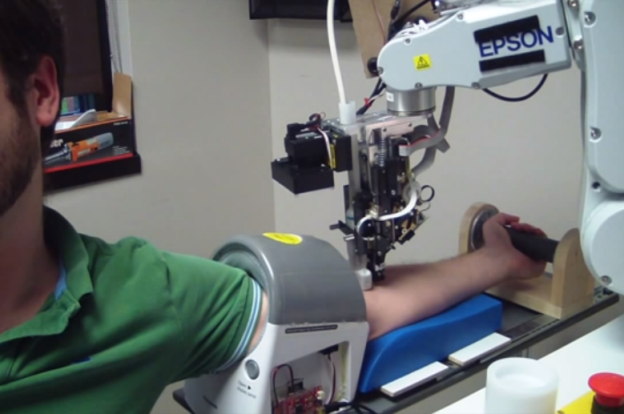
Getting your blood drawn is never a fun experience, and some people are better about it than others. There are the ones who can sit still and not make a peep, and those who hyperventilate, cry, faint at the sight of blood. Then there are those who have real medical conditions, like requiring butterfly needles for smaller veins or gentler pressure to avoid bruising.
A Mountain View, CA-based startup is trying to make that process more at ease. With the Veebot, this medical robot technician can scan the patient’s arm using an image-analysis software to select the vein that’s ideal for drawing blood. The patient would first insert his or her arm through a padded archway where an inflatable cuff pumps the arm to restrict blood flow. Then, Veebot will use ultrasound and infrared light to examine the best vein before aligning the needle and inserting it through. There’s even a grip for the patient to hold to help pump blood (or squeeze for nervousness). The team estimates that Veebot only takes one minute to process all this information – the only thing the human nurse has to do is attach the blood test tube and, of course, supervise the patient in case they pass out.
At the moment, Veebot has an 83 percent accuracy at selecting the best vein, which is more than some of us can say about nurses who poke and prod multiple times before they find a useable spot. The team is currently working on upping that rate to 90 percent accuracy before starting clinical trials. Veebot’s Richard Harris, a third-year undergraduate in Princeton University’s mechanical engineering program, tells IEEE Spectrum that the idea started because it combined his love for both robotics and computer vision. “It had demanding requirements because you’d be fully automating something that is different every time and deals with humans,” he explained. Such complexities did not come without obstacles; the original prototypes for Veebot date all the way back to 2009.
Now that a successful version is nearly ready, Harris is gearing up to sell to large medical facilities with an estimated market of $9 million. But before you shy away thinking this robot will probably try to kill you while you’re not looking, look at it this way: Surgical robots have existed for years and are pretty common in most hospitals these days. A blood test is much less complex than surgery, so the process can’t be that bad… right? Besides, if you don’t like Veebot, there are plenty of other robots that can help you draw some blood – and it ain’t gonna be pretty.


